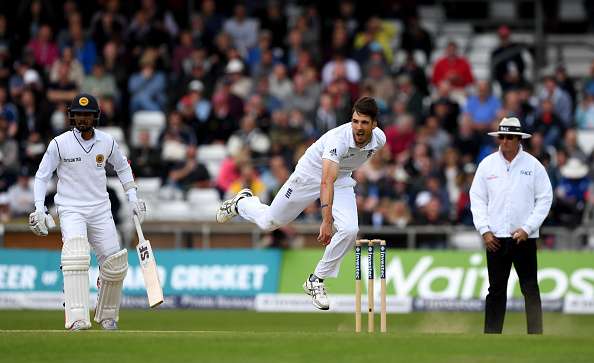There is another game Steven Finn appears to be playing alongside cricket at the moment – Snakes and Ladders.
Finn, a 6ft 8in fast bowler, is 27 and has played 31 Tests, so is no rookie. But every time he looks to have risen a rung or two with his bowling, he suffers a setback – the last one being injury in South Africa – which takes him all the way back to square one.
His bowling for England in the current series against Sri Lanka, and for Middlesex in the County Championship, has been leaden and uninspired, though not from want of trying.
In the first two Tests, he has taken four wickets for 148 runs – the tally of a batsman who bowls useful seam up, not a strike bowler.
Finn has been here before.
Indeed, he appears to get rebooted after every break he has – fine if you are a computer able to return exactly to where you left off, not so good if you are a bowler forced to retread a familiar path with all the old pitfalls just to get to your last destination.
The point of experience, as a bowler, is that it should help you to become an increasingly efficient wicket-taker. And that is the thing about Finn, he is not very efficient.
As superbly honed as Jimmy Anderson’s bowling action is, Finn’s always looks on the verge of falling apart – his flailing limbs redolent of a man trying to negotiate hot coals barefoot while trying to swat a thousand midges, all at once.
There are a lot of moving parts to Finn’s bowling action and a lot of mental checks to be made, so by extension there is a lot that can go wrong, especially with his timing and rhythm.
At Durham, if the speed gun can be trusted, he was clocking 81-85mph. That is only just above medium pace and not something he was picked for.
In the past, whenever he has struggled with his action, he has always managed to keep taking wickets – a knack that appears to have deserted him.
Nevertheless, he possesses the sixth best strike-rate in Test history for bowlers with more than 100 Test wickets on covered pitches, up there with the great fast bowlers like Malcolm Marshall, Dale Steyn, Allan Donald and Waqar Younis. So there is quality there.
His last crisis, if we can be so dramatic, came four years ago when his floppy right leg kept collapsing at the crease and knocking the bails off at the non-striker’s end as he bowled.
It was a strange habit and one the International Cricket Council essentially cured for him by making it a no-ball, after batsmen complained to being put off by it.
That led to a nadir on the Ashes tour which followed, where he was deemed “unselectable” by Ashley Giles, England’s one-day coach at the time.
But while he claims to be over the funky knee, the remnants of something like that never go completely, being ready to pop back into a bowler’s head the moment doubt begins to triumph over certainty.
The psychology of fast bowling is directed as much at one’s self as one’s opponent. Knowing what is possible and more, when the body is feeling below par and the ball not coming out well, is a major part of it.
Like a batsman making ugly runs, bowlers have to find a way of being effective when they are below par, which will be 60 per cent of the time. Absolute perfection happens once or twice a season, something Finn needs to understand quickly.
At the moment, Ben Stokes (when he is fit) and Chris Woakes allow England to play a five-man attack which can carry one passenger, especially with Anderson and Stuart Broad ranked one and three in the world respectively at present, but also against a team as nervy in English conditions as Sri Lanka.
But a four-man attack with Finn in it, especially given that Moeen Ali is not good at containing, would be exposed at present, especially against a better batting side.
In the past, Finn has suffered from listening to too many people wielding advice. I don’t know if someone has got into his ear this time, telling him he needs to be flexible, i.e. able to swing when conditions allow, or be Glenn McGrath accurate when it is flat, but he appears conflicted.
If he looks around the team, there is a niche that can be his, alone, but he needs to bowl fast to fill it. Finn might want to be a surgeon with ball in hand, but England need him to be a battering ram.
At the risk of being one of those bores telling him what to do, Finn must clear his head of all frippery, fix a gimlet eye upon his prey, charge in and hit the pitch just outside off-stump on a challenging length, as hard as possible.
As a variation, he can bowl bouncers and the odd yorker.
Otherwise, fast and nasty, whether angled in or away, is what the team and his fans desire.
In a five-man attack he can, and must, go flat out, as it is unlikely he will need to conserve energy for that long third spell. I always thought that the perfect template for Finn was an action like Jason Gillespie’s. Short, purposeful, bounding run; a nice leap; and then bang, hit the deck with malice.
Trouble is, Finn likes running a long way, criss-crossing his legs as he approaches the crease and doesn’t really get airborne with his gather.
In defence, he will point to his record which, with that stellar strike-rate and 117 wickets in 31 Tests, is impressive, but for those of us who enjoy fast bowling from the safe side of the fence, he could be really special.
This piece originally featured in The Cricket Paper, Friday June 3 2016















